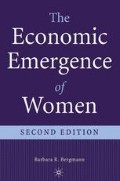Abstract
To be a housewife is to be a member of a very peculiar occupation—an occupation like no other. The nature of the duties to be performed, the method of payment, the form of supervision, the tenure system, the “market” in which the “workers” find “jobs,” and the physical hazards are all very different from the way things are in other occupations. The differences are so great that one tends not to think of a housewife as belonging to an occupation in the usual sense. It is commonly said that a housewife “doesn’t work” and that she “is unpaid.” The truth is, of course, that a housewife does work and does get recompense. Like other workers, she can quit or be fired. One dictionary defines an occupation as “an activity that serves as one’s regular source of livelihood.” Being a housewife is an activity that gets one food, clothing, and a place to live, and that certainly meets the dictionary’s definition of having an occupation.
Access this chapter
Tax calculation will be finalised at checkout
Purchases are for personal use only
Preview
Unable to display preview. Download preview PDF.
Notes
John Kenneth Galbraith, Economics and the Public Purpose (Boston: Houghton Mifflin, 1973), chapter 4.
Matthew D. Bramlett and William D. Mosher, First Marriage Dissolution, Divorce, and Remarriage: United States (Centers for Disease Control and Prevention, National Center for Health Statistics, May 31, 2001). The estimates pertain to the year 1995.
Patricia Tjaden and Nancy Thoennes, Extent, Nature, and Consequences of Intimate Partner Violence (U.S. Department of Justice, National Institute of Justice, July 2002).
Ruben Casteneda and Darragh Johnson, “Johnson, Ivey Mend Rift Over Abuse Case,” The Washington Post, March 18, 2003, p. B4.
See Lena Graber and John Miller, “Wages for Housework: The Movement and the Numbers,” Dollars and Sense (September/October 2002): 45–46.
For a different view of this matter, see Marilyn Waring, If Women Counted: A New Feminist Economics (San Francisco, CA: Harper & Row, 1988).
Lenore J. Weitzman, The Divorce Revolution (New York: The Free Press, 1985).
The discussion follows the ideas of Isabel V. Sawhill, “Developing Normative Standards for Child-Support Payments,” in Judith Cassetty (ed.), The Parental Child Support Obligation (Lexington, MA: Lexington Books, 1983).
Rolande Cuvillier, “The Housewife-An Unjustified Financial Burden on the Community,” Journal of Social Policy 8 (January 1979): 1–26.
For an explanation of how Social Security benefits are computed, see Barbara R. Bergmann, Is Social Security Broke? A Cartoon Guide to the Issues (Ann Arbor, MI: University of Michigan Press, 2001).
For detailed discussions of all of the major alternatives to the present system of computing Social Security benefits, see Richard V. Burkhouser and Karen C. Holden (eds), A Challenge to Social Security: The Changing Roles of Women and Men in American Society (New York: Academic Press, 1982).
Betty Friedan, The Feminine Mytique (New York: Norton, 1963).
Copyright information
© 2005 Barbara R. Bergmann
About this chapter
Cite this chapter
Bergmann, B.R. (2005). The Occupation of Housewife. In: The Economic Emergence of Women. Palgrave Macmillan, New York. https://doi.org/10.1057/9781403982582_9
Download citation
DOI: https://doi.org/10.1057/9781403982582_9
Publisher Name: Palgrave Macmillan, New York
Print ISBN: 978-0-312-23243-6
Online ISBN: 978-1-4039-8258-2
eBook Packages: Palgrave Social & Cultural Studies CollectionSocial Sciences (R0)

